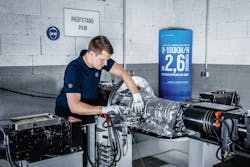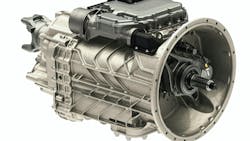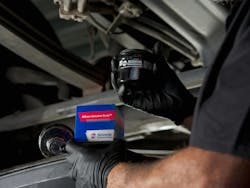As transmissions have become more electronically entangled with the engine, fleets have reaped several rewards in terms of performance and efficiency. But with more ECUs come more diagnostic trouble codes.
According to Gary Pfister, Eaton’s N.A. technical services manager, the Eaton Cummins Endurant transmission can produce in excess of 300 fault code variations. “In our older products, we had maybe 75 fault codes,” he said.
Understanding what these mean, and if and how these faults can impact the truck, are critical to keeping performance at a maximum and unplanned downtime to a minimum.
For instance, with the Endurant, a fault code in the 100 series indicates a problem in the chassis, such as a wiring or air issue, while a 200 or 300 series “is more than likely something on our side of the world that we need to address,” Pfister explained.
Addressing those hasn’t been easy, though.
“There’s a number of uphill battles, especially with the newer technologies,” Pfister noted. The last decade has been more difficult in terms of transmissions, as the industry has “leapfrogged technology.”
“And we’re still catching up; we’re learning every day,” Pfister said.
To help maintenance teams catch up and ensure that transmission issues can be detected and resolved in a timely manner, we caught up with some transmission experts who offered several tips to improve the troubleshooting process.
Common transmission hiccups
When it comes to unexpected transmission issues, a few are more common than others.
The number-one transmission problem is electrical, Pfister relayed. “It can be a number of things—anything from OEM chassis wiring, to a bad component, to routing of wires, things of that nature.”
Electrical issues require meticulous troubleshooting and diagnosing, or a technician runs the risk of overlooking the root cause of a problem that could be causing multiple fault codes. And with modern powertrains becoming increasingly interconnected, tiptoeing around electrical problems is not an option.
Pfister mentioned that another common problem is with the air system. Some newer transmissions have a pneumatically operated mechatronic transmission module on them, which combines the sensors and solenoids into a single unit to reduce the size of the transmission without sacrificing efficiency.
“Those are much more sensitive, because a mechatronic module uses solenoids and spool valves to select the gears,” he said. “If you get contamination, then that module can stick those spool valves, so now you get an issue where the truck won’t shift.”
Read more: ZF launches transmission production scaling, introduces new EV transmission for 2025
A whole host of other transmission problems can come as a result of incorrect maintenance practices. For example, using incorrect fluid or non-genuine parts during maintenance can lead to poor performance and durability in the long term, said Greg King, head of North American Transmission Service at ZF Group.
“The components used in the transmission are designed to specific tolerances and of precise material specification,” King said, “so the use of non-genuine replacement parts might not match the materials and specifications of original OEM components, resulting in reduced performance and product life.”
This sentiment is echoed by Gary Burns, Allison Transmission’s director of customer support and channel development for North America. He emphasized that proper maintenance practices include not only “the use of proper fluid and filters but also maintaining driveline and other powertrain components in accordance with vehicle manufacturer guidelines.”
While straying from OEM recommendations to purchase aftermarket and off-brand parts can seem like an easy way to save a few dollars here and there, cutting corners never pays off when it comes to the long-term health of your fleet.
Decoding dash lights
“Modern commercial vehicle transmissions are equipped with mechatronics, transmission control units, and sensors which can identify when there is an issue in the transmission that requires maintenance or when performance is not optimal,” King explained.
When a fault is detected due to these situations, the check-light on the dash alerts the driver that intervention may be required. Pfister notes that while every OEM has these dash indicators, what trips them could vary.
And beware taking DTCs at face value when they roll into the shop. It’s also crucial for technicians to distinguish between a DTC generated by a transmission issue and similar-looking malfunctions from a different system.
“It is not always obvious to the vehicle operator,” King explained. “For instance, with modern electronics that communicate over a vehicle network, errors in that communication can appear to be a transmission fault but are elsewhere in the vehicle.”
This piece of the puzzle was also pointed out by Joe Scarnecchia, powertrain sales manager for Mack Trucks. He said “the first thing to remember is that the issue may not be mechanical. It could be an electronic, programming, or software issue.”
This highlights the importance of careful troubleshooting, especially if the only indication of an issue is a dash light instead of a noticeable drop in powertrain performance. Beginning a repair on the transmission itself would be a waste of time and resources if the root cause is actually just an error in the vehicle’s electronic network.
King offered an example: “Many vehicles have inclinometers to know if the vehicle is climbing or descending a hill. The engine and transmission use that information to adjust operating parameters that affect performance,” he continued. “If that sensor is faulty for any reason, it impacts the powertrain performance and could easily cause misleading faults in the other components.”
Identifying transmission problems versus issues with other parts of the drivetrain isn’t always so straightforward either, said Alex Reid, vocational marketing manager at Kenworth.
“Mechanical damage to other components of the powertrain may create similar symptoms that require further investigation,” he said, but “shift issues are usually obvious.”
Scarnecchia noted that an indicator like noise coming from the transmission would usually be a sign of an internal problem, but something like vibration, for example, could be more ambiguous. This could be indicative of a problem relating to the transmission, driveline, or rear axle.
Allison’s Burns similarly explained that “an impending transmission issue may be indicated by a noticeable difference in operation, such as ‘slipping,’” among other items, but that an issue that initially seems like a transmission malfunction can actually stem from poor maintenance, “which can result in lack of lubrication, cooling issues, or torsional activity,” he said.
About the Author

Lucas Roberto
Lucas Roberto is an Associate Editor for Fleet Maintenance magazine. He has written and produced multimedia content over the past few years and is a newcomer to the commercial vehicle industry. He holds a bachelor's in media production and a master's in communication from High Point University in North Carolina.


